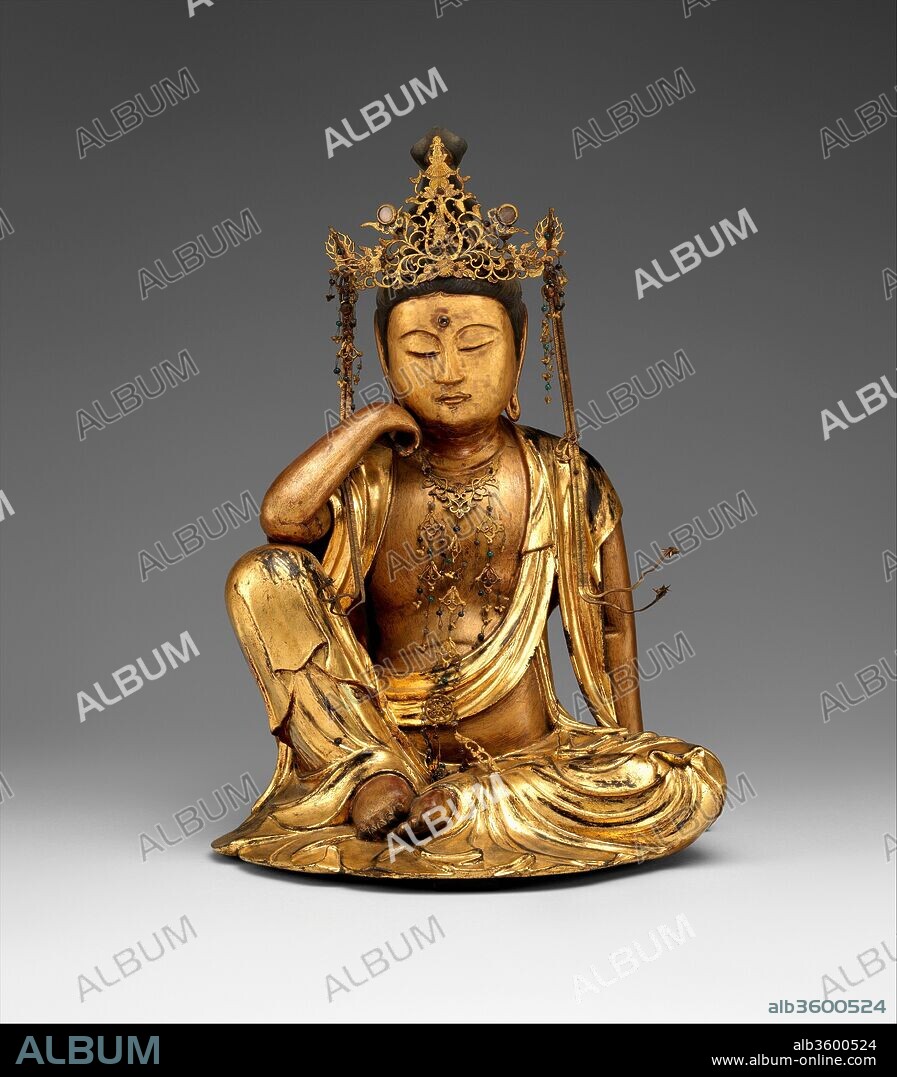alb3600524
Nyoirin Kannon

|
Zu einem anderen Lightbox hinzufügen |
|
Zu einem anderen Lightbox hinzufügen |



Haben Sie bereits ein Konto? Anmelden
Sie haben kein Konto? Registrieren
Dieses Bild kaufen.
Nutzung auswählen:

Titel:
Nyoirin Kannon
Untertitel:
Automatische Übersetzung: Nyoirin Kannon. Kultur: Japan. Abmessungen: H. 16 9/16 in. (42,1 cm); B. 12 1/8 Zoll (30,8 cm); D. 10 1/4 in. (26 cm). Datum: datiert 1693. Der Bodhisattva Kannon (Sanskrit: Avalokiteshvara) manifestiert sich in vielen Formen, von denen jede Aspekte seines Mitgefühls und seiner Heilsgelübde demonstriert. Diese kleine Skulptur zeigt den Bodhisattva in einer esoterisch-buddhistischen Form namens Nyoirin, die auf die Attribute hinweist, die am häufigsten in seinen Händen gehalten werden, das wunscherfüllende Juwel (nyoi) und das Rad (rin) des Dharma oder der buddhistischen Lehren. Während viele Bilder des Bodhisattva sechs Arme haben, hat diese Skulptur zwei. Eine in den Sockel gehauene Inschrift weist darauf hin, dass es sich um eine Votivgabe an einen Tempel handelte, die im fünften Monat des Jahres 1693 gegeben wurde. Da die Namen der Spender darauf hindeuten, dass es sich um Frauen handelte, ist es möglich, dass die Skulptur anlässlich eines Monats geweiht wurde ein in der Edo-Zeit beliebtes Ritual namens Jukuya-ko, eine Versammlung weiblicher Buddhisten, die am 19. des Monats für die Gesundheit und die sichere Geburt von Kindern stattfand. Aus der Edo-Zeit stammen viele Steinreliefstelen, die eine zweiarmige Form des Bodhisattva darstellen, der am Tag dieses Ritus eingeweiht wird. Aufzeichnungen weisen darauf hin, dass zu dieser Zeit auch eine parallele Versammlung, die einer Shinto-Gottheit gewidmet war, weit verbreitet war.
Nyoirin Kannon. Culture: Japan. Dimensions: H. 16 9/16 in. (42.1 cm); W. 12 1/8 in. (30.8 cm); D. 10 1/4 in. (26 cm). Date: dated 1693.
The bodhisattva Kannon (Sanskrit: Avalokiteshvara) manifests in many forms, each of which demonstrates aspects of his compassion and salvific vows. This small sculpture shows the bodhisattva in an Esoteric Buddhist form called Nyoirin, indicating the attributes most commonly held in his hands, the wish-fulfilling jewel (nyoi) and the wheel (rin) of the Dharma, or Buddhist teachings. While many images of the bodhisattva have six arms, this sculpture has two. An inscription carved into the base indicates that it was a votive offering to a temple given in the fifth month of 1693. As the names of the donors indicate that they were women, it is possible that the sculpture was dedicated on the occasion of a monthly ritual popular in the Edo period called the jukuya-ko, an assembly of female Buddhists that took place on the nineteenth of the month for health and the safe delivery of children. Many stone relief stelae depicting a two-armed form of the bodhisattva dedicated on the day of this rite remain from the Edo period. Records indicate that a parallel assembly dedicated to a Shinto deity was also prevalent at the time.
Technik/Material:
Wood with gold, gold leaf, lacquer, and crystal inlay
Zeitraum:
Edo period (1615-1868)
Museum:
Metropolitan Museum of Art, New York, USA
Bildnachweis:
Album
Freigaben (Releases):
Bildgröße:
3549 x 4053 px | 41.2 MB
Druckgröße:
30.0 x 34.3 cm | 11.8 x 13.5 in (300 dpi)
Schlüsselwörter:


 Pinterest
Pinterest Twitter
Twitter Facebook
Facebook Link kopieren
Link kopieren Email
Email
